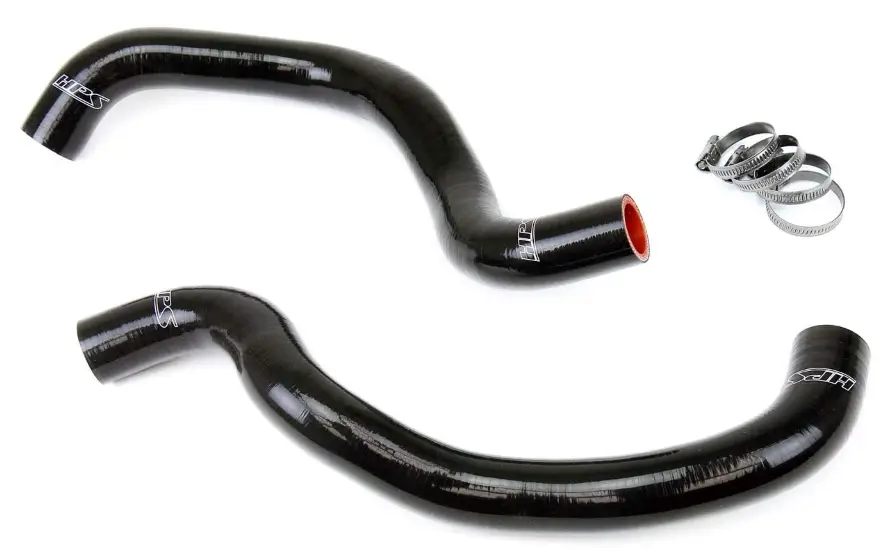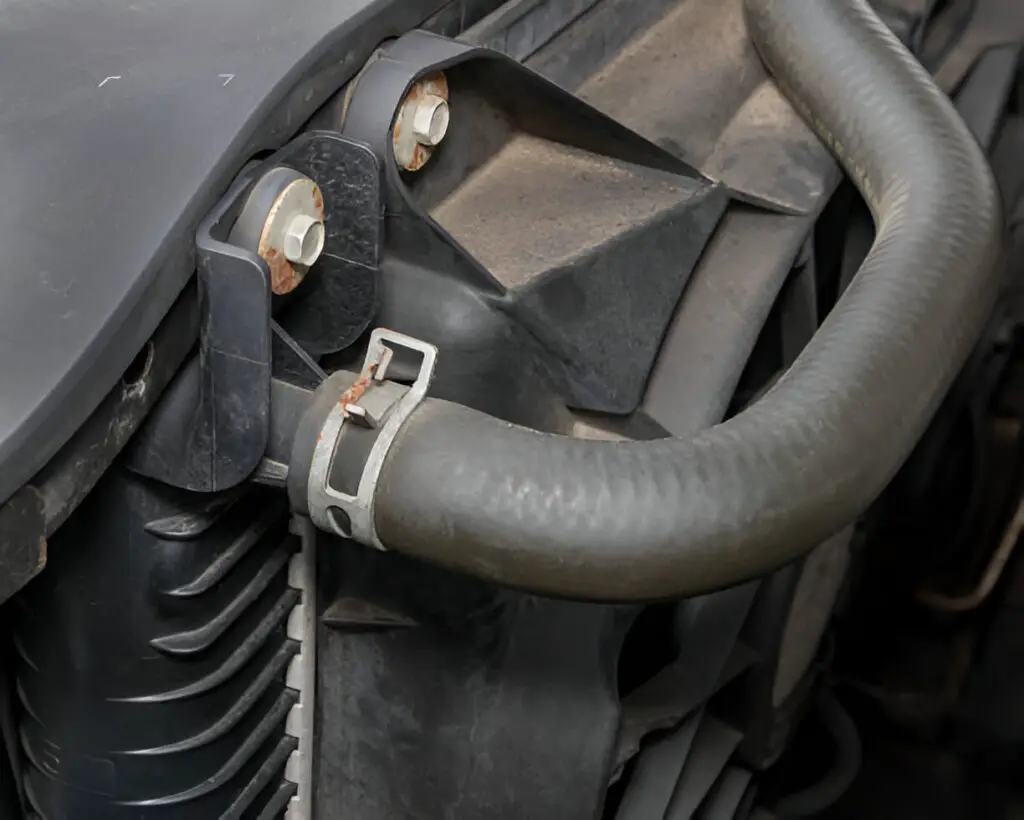Radiator hoses play a crucial role in a vehicle’s cooling system, allowing coolant to flow between the engine and the radiator, preventing overheating, and maintaining optimal engine temperature. However, these hoses are subjected to extreme temperatures, pressure, and constant use, leading to wear and potential failure over time. Understanding the lifespan of radiator hoses, recognizing signs of wear, and knowing when to replace them can help prevent engine damage and keep your car running smoothly.
In this post, we will cover the typical lifespan of radiator hoses, factors affecting their durability, signs that indicate it’s time for replacement, maintenance tips, and frequently asked questions.

Contents
What is the Average Radiator Hose Lifespan
The average lifespan of radiator hoses can range from 4 to 10 years or 50,000 to 100,000 miles, depending on various factors. This range is quite broad because radiator hoses’ durability is influenced by factors such as:
- Quality of the Hose Material: Rubber hoses typically last around 4-5 years, whereas silicone radiator hoses have longer durability and can exceed the 10-year mark.
- Driving Conditions: Frequent stop-and-go driving, extreme weather, and high engine loads can accelerate wear.
- Vehicle Maintenance: Regular maintenance, such as coolant replacement and hose inspections, can extend the hose lifespan.
- Heat and Pressure Exposure: Consistent exposure to high engine temperatures and coolant pressure can weaken the hose over time.
High-quality hoses, such as those made from silicone or EPDM (ethylene propylene diene monomer), generally last longer and are more resistant to heat and pressure. On the other hand, standard rubber hoses are prone to degradation over time and may require more frequent replacements.
Factors Affecting Radiator Hose Lifespan
The durability of radiator hoses is influenced by several environmental and maintenance-related factors:
1. Material Quality
Radiator hoses are typically made from rubber, silicone, or EPDM, each with distinct durability levels:
- Rubber Hoses: The most common type, these hoses provide flexibility and cost-effectiveness but have a shorter lifespan compared to other materials. Rubber hoses are prone to cracking, drying out, and losing flexibility over time.
- Silicone Hoses: These hoses are more durable, heat-resistant, and flexible. While they are more expensive, they can last significantly longer and are often used in high-performance or heavy-duty vehicles.
- EPDM Hoses: Made from synthetic rubber, EPDM hoses are resistant to heat, oxidation, and weathering. They typically have a longer lifespan than regular rubber hoses.
2. Driving Habits and Conditions
Vehicles that frequently experience stop-and-go traffic, prolonged idling, or heavy towing can put additional stress on radiator hoses. In addition, extreme weather conditions (both hot and cold) can accelerate the wear on hoses as they expand and contract with temperature fluctuations.
3. Heat and Pressure Levels
Radiator hoses are designed to handle significant heat and pressure. However, constant exposure to extreme heat and pressure can lead to micro-cracks and thinning, reducing the hose’s strength over time. A faulty thermostat, clogged radiator, or malfunctioning water pump can increase heat and pressure levels, further accelerating wear.
4. Coolant Quality and Maintenance
Coolant is vital in reducing engine temperature and preventing overheating, but it also plays a role in hose longevity. Poor-quality or old coolant can become acidic, corroding the inside of radiator hoses and decreasing their lifespan. Regularly radiator coolant flushing and replacing can prevent this issue and prolong hose life.
5. Improper Installation
Incorrect installation can lead to unnecessary stress on the hoses, causing premature wear. Over-tightening clamps, twisting hoses, or leaving hoses too close to engine components can lead to weak spots, which may result in leaks or ruptures.

How to Extend Radiator Hose Lifespan
Regular maintenance can extend the lifespan of radiator hoses, preventing unexpected issues and reducing overall repair costs. Here are some tips for keeping your hoses in optimal condition:
1. Perform Regular Visual Inspections: Check the hoses periodically for any visible signs of wear, cracks, or bulges. Visual inspections can catch issues early on, especially if done every time you change the oil or have your vehicle serviced.
2. Replace Coolant on Schedule: Old or contaminated coolant can corrode the inside of the hoses, so it’s crucial to change it at the recommended intervals. Most manufacturers recommend flushing the cooling system every 30,000 to 60,000 miles, depending on your vehicle type and the coolant quality.
3. Avoid Over-Tightening Clamps: When replacing hoses or clamps, be careful not to overtighten them. Excessive pressure from clamps can cause hose damage, leading to leaks and reduced durability.
4. Park in Shaded or Covered Areas: While it’s not always possible, parking in shaded or covered areas can protect hoses from extreme heat, prolonging their lifespan. High temperatures can accelerate rubber degradation, causing hoses to crack or soften prematurely.
5. Replace Hoses in Pairs: If you need to replace one hose, consider replacing both the upper and lower hoses simultaneously. Typically, both hoses undergo similar wear, and replacing them together can prevent repeated repair costs.
Frequently Asked Questions
Here are some FAQs about radiator hose life expectancy –
1. How often should radiator hoses be replaced?
Radiator hoses typically need replacement every 4-10 years or 50,000 to 100,000 miles. However, you should inspect hoses regularly, and if you notice any visible wear, cracks, bulges, or signs of leaks, it’s best to replace them immediately.
2. Can I drive with a leaking radiator hose?
Driving with a leaking radiator hose is not recommended, as coolant loss can lead to engine overheating and severe damage. If you notice a leak, it’s best to stop driving and have the hose repaired or replaced promptly.
3. Are silicone hoses better than rubber hoses?
Silicone hoses generally offer better durability, heat resistance, and flexibility compared to rubber hoses, making them suitable for high-performance vehicles and extreme conditions. However, they are also more expensive, so the choice depends on your vehicle’s needs and your budget.
4. What causes radiator hoses to burst?
Radiator hoses can burst due to excessive internal pressure, high temperatures, material degradation, or weak spots from improper installation. Regular inspections and maintenance, such as coolant replacement and hose checkups, can help prevent these issues.
5. Can I replace radiator hoses myself?
Replacing radiator hoses can be a manageable DIY task if you have some automotive experience and the proper tools. However, for those unfamiliar with car repairs, it may be best to have a professional handle the replacement to ensure proper installation and avoid potential issues.
Conclusion
Radiator hoses are an essential component of your vehicle’s cooling system, and their condition directly affects engine performance and durability. By understanding the factors influencing radiator hose lifespan, regularly inspecting for wear, and practicing preventive maintenance, you can prevent premature failure and costly repairs.
Remember, replacing radiator hoses at the recommended intervals and addressing signs of wear early can extend their lifespan, keep your engine running smoothly, and enhance the overall reliability of your vehicle.